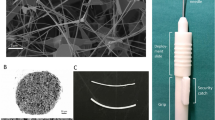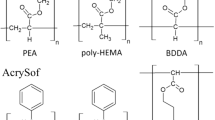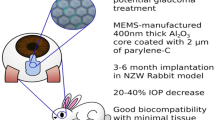Abstract
⊎ Background: In glaucoma surgery, e.g. cyclodialysis ab interno, to date no viscous substances have been available that stay in the cyclodialysis cleft long enough to prevent scarring. We examined the qualities of two different viscoelastic substances that stay longer in the place of instillation than hyaluronic acid. ⊎ Methods: We performed cyclodialysis ab interno in 12 eyes of six owl monkeys. The right eyes were treated with the gel with the higher molecular weight, the left eyes using the gel with the lower molecular weight. The baseline data of intraocular pressure and outflow facility were compared to the values measured postoperatively up to the 140th day. Histological examination of the eyes followed. ⊎ Results: There was no statistically significant difference between the two substances. The mean intraocular pressure decrease was 7.9 (±2.9) mmHg in the right eyes and 4.8 (±2.7) mmHg in the left eyes. The histological examination showed that the gel had remained in the cyclodialysis cleft without signs of inflammation. In contrast to other viscoelastic substances studied previously, the substances in this study performed their space-retaining function without decreasing outflow facility. ⊎ Conclusion: Both substances are suitable means of improving the rate of success of cyclodialysis ab interno, as they remain where they are instilled long enough to prevent wound scarring in the cyclodialysis cleft.
Similar content being viewed by others
References
Balazs EA (1988) Hyaluron and molecular matrices (hylans) for ophthalmic viscosurgery. Ber Dtsch Ophthalmol Ges 115:87
Bill A (1966) The routes for bulk drainage of aqueous humour in rabbits with and without cyclodialysis. Doc Ophthalmol 20:157
Bill A (1971) Effects of longstanding stepwise increments in eye pressure on the rate of aqueous humor formation in a primate (Cercopithecus ethiops). Exp Eye Res 12:184
Bill A, Phillips CI (1971) Uveoscleral drainage of aqueous humor in human eyes. Exp Eye Res 12:275
Dannheim R, Bárány EH (1968) Attempts at reverse perfusion of the trabecular meshwork in different monkey spezies. Invest Ophthalmol 7:305–318
Desjardins DC, Parrish RK II, Folberg R, et al. (1986) Wound healing after filtering surgery in owl monkeys. Arch Ophthalmol 104:1835
Draeger J, Wirt H (1984) Methodische Überlegungen zur Goniotomie und Zyklodialyse. Klin Mbl Augenheilkd 184:400–402
Goldmann H (1951) Über die Wirkungsweise der Cyclodialyse. Ophthalmologica (Basel) 121:94–100
Inaba ZU (1982) Long-term results of trabeculectomy in the Japanese: an analysis of the life table method. Jpn J Ophthalmol 26:361
Jampel HD, McGuigan LJB, Dunkelberger GR, et al. (1988) Cellular proliferation after experimental glaucoma filtration surgery. Arch Ophthalmol 106:89
Toris CI, Pederson J (1985) Effect of intraocular pressure on uveoscleral outflow following cyclodialysis in the monkey eye. Invest Ophthalmol Vis Sci 26:1745–1749
Wirt H, Bill A, Draeger J (1991) Neue Aspekte in der operativen Behandlung des Glaukoms — Vergleich viskoelastischer Substanzen in der Kammerwinkelchirurgie. Fortschr Ophthalmol [Suppl] 88:234. 89
Author information
Authors and Affiliations
Rights and permissions
About this article
Cite this article
Klemm, M., Balazs, A., Draeger, J. et al. Experimental use of space-retaining substances with extended duration: functional and morphological results. Graefe's Arch Clin Exp Ophthalmol 233, 592–597 (1995). https://doi.org/10.1007/BF00404711
Received:
Revised:
Accepted:
Issue Date:
DOI: https://doi.org/10.1007/BF00404711




